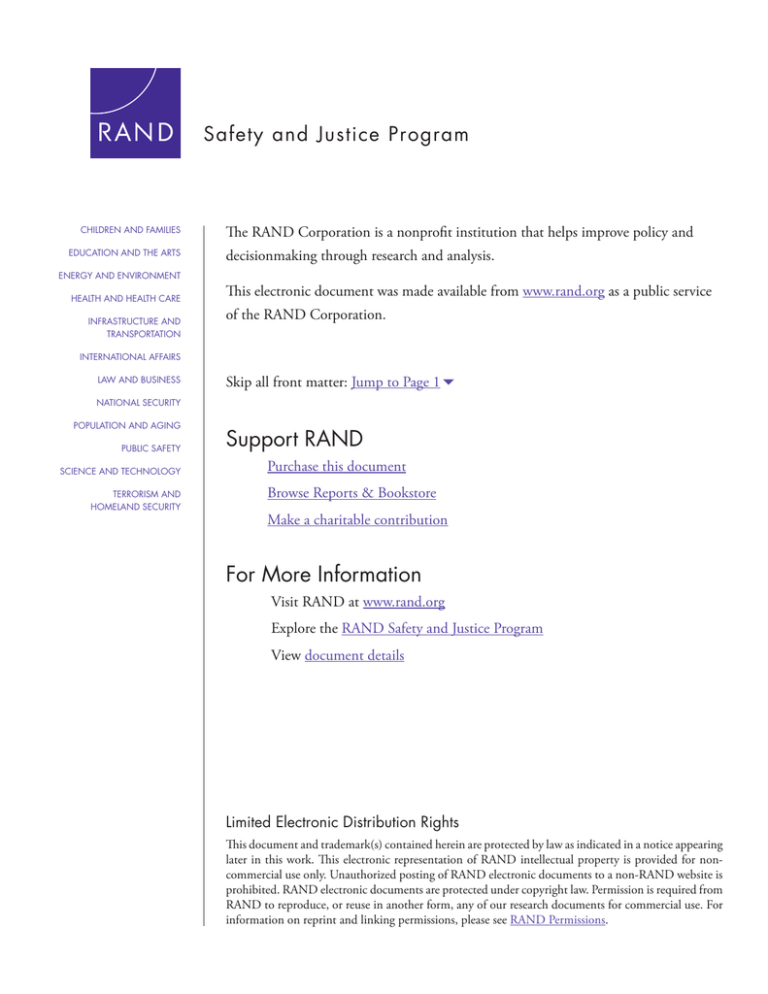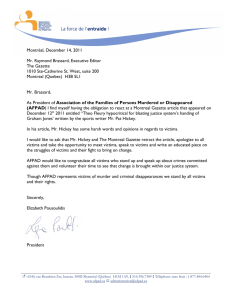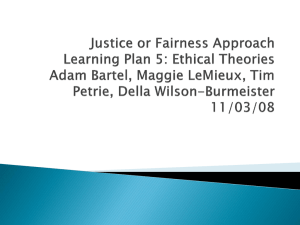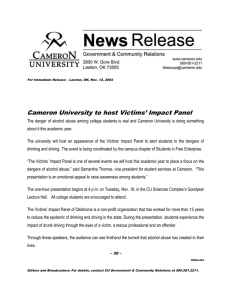Safety and Justice Program
advertisement

Safety and Justice Program CHILDREN AND FAMILIES EDUCATION AND THE ARTS The RAND Corporation is a nonprofit institution that helps improve policy and decisionmaking through research and analysis. ENERGY AND ENVIRONMENT HEALTH AND HEALTH CARE INFRASTRUCTURE AND TRANSPORTATION This electronic document was made available from www.rand.org as a public service of the RAND Corporation. INTERNATIONAL AFFAIRS LAW AND BUSINESS Skip all front matter: Jump to Page 16 NATIONAL SECURITY POPULATION AND AGING PUBLIC SAFETY SCIENCE AND TECHNOLOGY TERRORISM AND HOMELAND SECURITY Support RAND Purchase this document Browse Reports & Bookstore Make a charitable contribution For More Information Visit RAND at www.rand.org Explore the RAND Safety and Justice Program View document details Limited Electronic Distribution Rights This document and trademark(s) contained herein are protected by law as indicated in a notice appearing later in this work. This electronic representation of RAND intellectual property is provided for noncommercial use only. Unauthorized posting of RAND electronic documents to a non-RAND website is prohibited. RAND electronic documents are protected under copyright law. Permission is required from RAND to reproduce, or reuse in another form, any of our research documents for commercial use. For information on reprint and linking permissions, please see RAND Permissions. This product is part of the RAND Corporation technical report series. Reports may include research findings on a specific topic that is limited in scope; present discussions of the methodology employed in research; provide literature reviews, survey instruments, modeling exercises, guidelines for practitioners and research professionals, and supporting documentation; or deliver preliminary findings. All RAND reports undergo rigorous peer review to ensure that they meet high standards for research quality and objectivity. technic a l REP O RT No More Rights Without Remedies An Impact Evaluation of the National Crime Victim Law Institute’s Victims’ Rights Clinics Robert C. Davis • James M. Anderson • Susan Howley • Carol Dorris • Julie Whitman Sponsored by the National Institute of Justice Safety and Justice Program This project was sponsored by the National Institute of Justice and was conducted in the Safety and Justice Program of R AND Justice, Infrastructure, and Environment. The project was supported by Award No. 2007-VF-GX-0004, awarded by the National Institute of Justice, Office of Justice Programs, U.S. Department of Justice. The opinions, findings, and conclusions or recommendations expressed in this publication are those of the authors and do not necessarily reflect those of the Department of Justice. Library of Congress Cataloging-in-Publication Data Davis, Robert C. (Robert Carl) No more rights without remedies : an impact evaluation of the National Crime Victim Law Institute's victims' rights clinics / Robert C. Davis [and four others]. pages cm Includes bibliographical references. ISBN 978-0-8330-7866-7 (pbk. : alk. paper) 1. Victims of crimes—Legal status, laws, etc.—United States. 2. Criminal justice, Administration of—United States. 3. Privacy, Right of—United States. I. Securing rights for victims. II. Title. KF9763.D38 2012 362.88'1560973—dc23 2012050177 The R AND Corporation is a nonprofit institution that helps improve policy and decisionmaking through research and analysis. RAND’s publications do not necessarily reflect the opinions of its research clients and sponsors. R® is a registered trademark. © Copyright 2012 RAND Corporation Permission is given to duplicate this document for personal use only, as long as it is unaltered and complete. Copies may not be duplicated for commercial purposes. Unauthorized posting of RAND documents to a non-RAND website is prohibited. RAND documents are protected under copyright law. For information on reprint and linking permissions, please visit the RAND permissions page (http://www.rand.org/publications/ permissions.html). Published 2012 by the RAND Corporation 1776 Main Street, P.O. Box 2138, Santa Monica, CA 90407-2138 1200 South Hayes Street, Arlington, VA 22202-5050 4570 Fifth Avenue, Suite 600, Pittsburgh, PA 15213-2665 RAND URL: http://www.rand.org To order RAND documents or to obtain additional information, contact Distribution Services: Telephone: (310) 451-7002; Fax: (310) 451-6915; Email: order@rand.org Summary The National Crime Victim Law Institute (NCVLI) victims’ rights clinics are an effort to remedy what many perceived as a serious deficit in victims’ rights legislation. Although all states have laws protecting victims’ rights and many have constitutional amendments establishing rights for victims, the rights of many victims still are not honored or observed. In large measure, this may be because there are no remedies enforceable when victims are denied their rights. The NCVLI clinics were intended to promote awareness, education, and enforcement of crime victims’ rights in the criminal justice system. The victims’ rights clinics sought to protect and enforce rights for victims in the court process through filing motions in criminal cases in which victims’ rights were denied and by seeking appellate decisions that interpreted and reinforced victims’ rights statutes. By providing direct representation to individual victims in criminal court, NCVLI hoped not only to increase the observance of rights in those particular cases but also to increase awareness of victims’ rights by prosecutors, judges, and police officers in general. Assessing the impact of the NCVLI clinics is a difficult task in part because the clinics have two distinct foci: to alter the “legal landscape” with respect to victims’ rights and to promote the rights of victims in individual cases. To try to capture the scope of clinic activities, the impact evaluation employed multiple methods. We sought to determine how clinic representation affected the exercise of rights in individual cases in several ways. First, we compared prosecutor case files in which victims were represented by clinic attorneys and similar cases in which victims did not have representation, for indications of how victims’ rights were addressed. Second, we surveyed victims in the two samples of cases to elicit their perspectives on whether their rights were observed and on their satisfaction with the justice process. We surveyed prosecutors, judges, victim advocates, and defense attorneys to ascertain their opinions about victims’ rights and about the NCVLI clinics. We examined legislation and court rules pertaining to victims’ rights before and after the start of the clinics. We also examined appellate decisions relating to victims’ rights pre- and postclinic. We examined the treatment of victims’ rights in the print media pre- and postclinic. Finally, we interviewed victims’ rights clinic directors to obtain and synthesize their thoughts on sustainability of the clinics. Key findings from the evaluation include the following: • Survey results indicated a shift toward more-favorable attitudes toward victims’ rights and greater compliance with victims’ rights by court officials after establishment of the clinics. The changes were small with respect to attitudes toward victims’ rights but larger with respect to perceptions of compliance with victims’ rights. xi xii No More Rights Without Remedies • In our analysis of prosecutor case files, we found differences in compliance on some measures in some jurisdictions between cases in which victims were represented by attorneys and those in which they were not. In the aggregate, however, the analysis of prosecutor files did not suggest an increase in compliance as a result of having a victims’ rights attorney. • According to our surveys of victims from the prosecutor case-file sample, victims represented by clinic attorneys more often reported that they were notified of defendants’ release from jail, that they had made a victim-impact statement, that they were notified of the case disposition, and that they were referred to counseling services. However, victims represented by clinic attorneys were also less satisfied with the way they were treated by court officials, less satisfied with the court process, and less satisfied with the outcomes of their cases. • We found some, but inconsistent, evidence that clinics made a difference in the expansion of victims’ rights both in terms of legislation related to victims’ rights and in terms of appellate decisions. • We did not find a consistent increase in the number of articles in the print media about victims’ rights, nor did we observe a change in the proportion of articles sympathetic to victims’ rights. The results of the impact evaluation indicate that victims’ rights clinics can make a difference in promoting the rights of victims in individual cases; they may help more generally to promote a more sympathetic view of victims’ rights among court officials; and they have had some influence in expanding the rights of victims in the states where they reside through their involvement in influential appellate decisions and legislative efforts. After assessing the information we gathered during the course of the process evaluation, we believe that the victims’ rights clinics have been somewhat successful in achieving their key goals. However, funding remains a problem for the clinics, and the current economic climate makes it unlikely that the demonstration clinics can be replicated on a large scale, using the current model.






